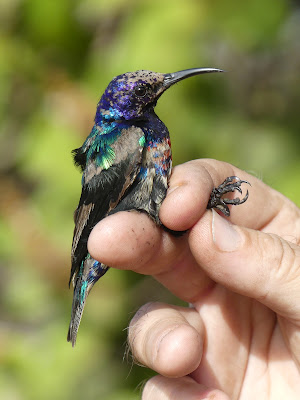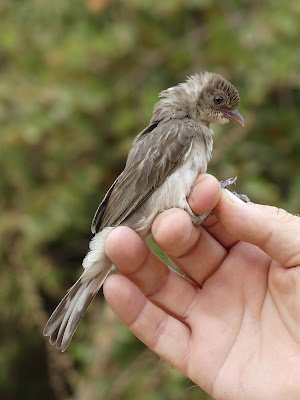A session to the south-east corner of Tanji reserve looked as though it may not go ahead at all when the driver failed to put the car into 4 wheel drive before ploughing the Pajero into soft sand. A little brute strength managed to free it, but instead of taking it easy he revved hard and in no time the rear nearside wheel was up to the axle in sand! So, plan A to drive to the area we reccied earlier was set aside and we carried the equipment to a place where we could see places to site four nets.
We were pleased to find a shady spot too and by the end of the morning had ringed 33 birds.
Immature African Pygmy Kingfisher
Immature Splendid Sunbird
AJ with Snowy-crowned Robin-chat
Other birds present included Tree Pipit, Common Nightingale and Blue-cheeked Bee-eaters. With the assistance of park rangers we had our vehicle back in an hour or so.
Day 13.
Back to Tanji Eco-reserve today for a modest 23 birds and a problem with monkeys. MS & AJ ended up stationed close to the nets to prevent the animals from approaching. New species for the day were Stone Partridge, Greater Honeyguide, Little Weaver, Blue-cheeked Bee-eater and Red-billed Quelea.
Adult female Greater Honeyguide
Blue-cheeked Bee-eater
Five nets up at Tanji Reserve (SE) brought a few more European migrants including our first Western Olivaceous Warbler.
Western Olivaceous Warbler
Amongst the Afro-tropical species were two Yellow-crowned Gonolek, a Tawny-flanked Prinia, 3 Beautiful Sunbird and some rather stunning adult Brown Babblers with the oh so striking orange eyes. There were Green Vervet close by in the trees and the nets closest to them needed very frequent monitoring.
Brown Babbler adult
We spent the afternoon inputting data and maintaining project funds records by the Tanji Eco-lodge drinking pool, and saw a few more beautiful birds.
Greater Honeyguide (immature)
Violet Turaco
After dark, for the fifth time since we arrived, we went down into the old quarry with a high powered torch to look for Nightjars. As occurred on the previous four nights, we were avoided by them, but did find and pick up a Senegal Thick-knee in the dried out pond.
Senegal Thick-knee
Day 15.
Tanji bird reserve (SE) again, this time further away from the large trees to reduce the risk of problems with monkeys. A large flock of Blue-cheeked Bee-eaters were in the area but only one was tempted into the nets, despite an 18m net being walked into a more open area. Again, there were new species for the trainees to experience, European migrants Blackcap, Common Redstart and Western Subalpine Warbler as well as Pied-winged Swallow and Yellow-fronted Tinkerbird.
Day 16.
A change today as we had received an invitation for our novice ringers, who had not seen the Kartong operations before, to observe a morning with the team there. We attended with AS & AJ. They very much enjoyed seeing a large scale ringing operation and got the opportunity to ring a few birds too, instructed by one of Kartong's Gambian ringers who is just coming up to a permit upgrade.
Later, we took a walk along the beach to find the Northern Carmine Bee-eaters.
Tanji bird reserve (SE) again, this time further away from the large trees to reduce the risk of problems with monkeys. A large flock of Blue-cheeked Bee-eaters were in the area but only one was tempted into the nets, despite an 18m net being walked into a more open area. Again, there were new species for the trainees to experience, European migrants Blackcap, Common Redstart and Western Subalpine Warbler as well as Pied-winged Swallow and Yellow-fronted Tinkerbird.
Male Greater Honeyguide
Pied-winged Swallow
Day 16.
A change today as we had received an invitation for our novice ringers, who had not seen the Kartong operations before, to observe a morning with the team there. We attended with AS & AJ. They very much enjoyed seeing a large scale ringing operation and got the opportunity to ring a few birds too, instructed by one of Kartong's Gambian ringers who is just coming up to a permit upgrade.
Later, we took a walk along the beach to find the Northern Carmine Bee-eaters.
Two of four Northern Carmine Bee-eaters seen
Followed, on the way back, by a detour to Bolong Fenyo community wildlife reserve. We were hoping to find waders that might be catchable at the lake. There were a few Spur-winged Plovers, and a Redshank. The large flock of gulls and smattering of terns looked very tempting, but commonsense prevailed and all four of us rejected the prospect of working close to the water, in the dark, with 20+ crocodiles in and around the lake. There were no waders on the beach to be forced up at high tide - even if there had been, we weren't working around that lake, especially not in the dark.














